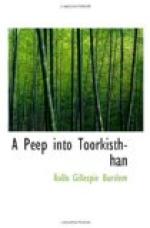On the 16th, after a long march of twenty-two miles, we approached Heibuk through the same kind of scenery as the preceding day; on rounding a projecting ledge of rock we saw that fortress in the distance, on an insulated eminence adjacent to a low range of hills. Meer Baber Beg has placed his fortress in a very respectable state of defence, quite adequate to repel the desultory inroads of his predatory neighbours; but commanded by and exposed to enfilade from the hills about it, on one of these hills he has built a tower as a kind of outwork, but it is very weak and of insignificant size.
The only thing worth seeing near Heibuk is the Tukt-i-Rustum or Throne of Hercules, which we accordingly visited, and found it to be a fortification of no very great extent on a most uncommon principle, and of unknown date. The best idea I can convey to the reader of its shape, is by begging him to cut an orange in half, and place its flat surface in a saucer; he will then have a tolerable model of the Tukt-i-Rustum. We entered by a narrow gallery piercing through the solid mass of rock which forms the outer wall or saucer, and leading by an irregular flight of steps to the summit of the orange. I instituted many enquiries concerning the origin of this place, but I could obtain no information; not even a legend beyond that it was holy. We were accompanied by one of the chief’s sons, a fat jolly youth of about four-and-twenty, with a countenance that was a type of his good humour—he sat with us for some time whilst we were at our toilette, but affected to be somewhat shocked at the very scanty clothing which we considered sufficient while our Bheesties poured the contents of their mussocks[*] over us. It was rather amusing to hear the remarks of the bystanders, who seemed to view cleanliness as a consideration very secondary to etiquette. It would have been fortunate for us if I could have persuaded our criticising friends to try on their own persons the advantage of a dash of fresh water, for they were without exception the most filthy race it has ever been my misfortune to meet; their garments teem with life, and sometimes, after merely sitting on the same rug placed to receive visitors, I have been under the necessity of making a fresh toilette.
[* Note: Skins of water.]




